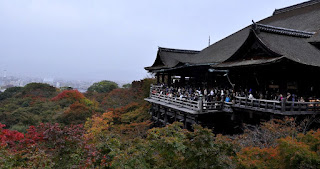The hard facts:
- visited 5 temples and 1 park, of which 2 are UNESCO World Heritage Sites
- paid 1500 ¥ for admission fees
- paid 1420 ¥ for transportation
- walked more than 15 km (see the track, but there's a section missing right at the beginning where I forgot to switch on the GPS receiver. I started at the train station, then went to visit the temple directly north of the station, and only then went to the temple in the west where the track starts)
This was the first ever sightseeing trip where I recorded a GPS track - now I know for sure why sightseeing is so damn exhausting! You just walk and walk and the kilometers accumulate and at the end you have covered a distance that you wouldn't want to cover in your daily workout.
I took a local train from Osaka to Kyoto (because local trains are much cheaper than express trains, such as the Shinkansen, and it still only took about 45 minutes). The first thing I did when I arrived was to check the tourist information center in Kyoto station. It wasn't very useful because it was very much geared towards Japanese tourists (i.e. there was no information in English available at all). However, I found one poster which I thought was very funny. It contained a detailed list of sights and places in Kyoto, indicating for each the current status of the autumn foliage using green and red maple leafs. I took the trouble to look for one specific place that I had planned to go to because the travel guide said it was one of the most beautiful places to visit in autumn. I found it after much comparing of Japanese characters on the poster with the ones in my travel guide, but it only had two green maple leafs and no red ones. So I didn't go there - I'll probably check again the next weekend.
 |
| Poster showing the status of autumn foliage around Kyoto |
After leaving the station, I walked a little north to visit my first temple, Higashi Hongan-ji. I have to say, I wasn't very impressed by this temple, although it apparently is one of the largest wooden buildings in the world. A common trait of most temples in Japan seems to be that they were repeatedly destroyed by fires, and thus the current buildings are all reconstructions of the original ones - that's probably the main reason why there are so many "No Smoking" signs all over the temples. In the case of Higashi Hongan-ji, the latest reconstruction was done in 1895. To aid the reconstruction, followers of the temple donated hair to make ropes that were used to lift the wooden beams. One of these ropes is exhibited in a glass case inside the temple.
2 - Nishi Hongan-ji
On to the second temple, and the first World Heritage Site in my visit. This one is a little bigger than the one before, and more impressive.
There also seemed to be a wedding taking place in the temple, and I took pictures of the bride and groom being prepared for the group photo.
3 - Kiyomizu-dera
The third temple, and second World Heritage Site, is the biggest of the temples today, and very crowded. There are various temple halls and shrines on the extensive grounds, and the visitors are led in a fairly fixed course through all of it.
Apparently, rubbing all kinds of statues brings luck, or answers prayers, or something. That's the reason why the one in the picture below is so polished.
At one place, there is a waterfall where people queue to get a drink from its sacred waters. I took a couple of pictures of how two Japanese girls in traditional clothing did it.
4 - Kodai-ji
Starting at this temple, my memory starts to blur a little. Maybe it would be better to visit less temples in one day, and instead throw in a castle for good measure...
5 - Maruyama-koen
This is a park you pass on the way from Kodai-ji to Shoren-in. To be honest, I was already fairly tired at this point, so I didn't really explore the park. Maybe I'll come back in spring, as this park is allegedly one of the most popular spots for cherry blossom viewing.
6 - Shoren-in
After the park, I had planned to visit another temple, Chion-in. However, it was already closed (it was only 4pm - wtf?), so I went on to Shoren-in. This was actually quite nice because it wasn't very crowded and the walking tour in the temple and temple grounds was well laid-out. I'll have to explain this a little bit. In all temples, you have to remove your shoes before entering any building. Most temples provide plastic bags for you to carry your shoes with you until you leave the building again. So that's where I run out of hands because there's the travel guide in one hand, and I need the other to operate my camera. That's why I don't appreciate it when I also have to carry my shoes with me. In Shoren-in, however, they have a shoe-rack at the entrance where you can leave your shoes, then take the tour around the interconnected buildings, then return to the entrance, put on your shoes, and take the tour around the temple grounds. In addition, they have some very fine painted sliding doors from the 16th century, and I also found the general atmosphere to be very nice and tranquil. So that was a beautiful ending to my first day of sightseeing.
















